IB Professor Eva Fischer Espouses Frogs—for Both Research and the K–12 Classroom
“We talk a lot about what we can do at the university level to increase diversity in STEM to reach other populations, etc. But I think if we don't worry about that until kids are 18 and we're at the university level, we've missed the boat. So I just think that we've got to start earlier.” — Eva Fischer

IB Professor Eva Fischer. (Image courtesy of Eva Fischer.)
October 7, 2020
There’s a new Integrative Biology professor in town—Eva Fischer—who is sold on frogs. She’s not only setting up a lab in order to research frog behaviors, but she champions their use in the Frogger School Program she’s helped to design for K–12 classrooms.
Fresh from her fellowship in Germany, Eva Fischer just arrived at Illinois in Fall 2020 to begin working as an Assistant Professor in the Department of Evolution, Ecology, and Behavior in the School of Integrative Biology (IB), where she’s slated to teach IB 270: Evolution of Molecules & Cells. Fischer, who completed her PhD at Colorado State, followed by a postdoc at Stanford, calls her first stint as an assistant professor both “exciting and very terrifying.”
Since her arrival at Illinois, Fischer has been involved with teaching and setting up her lab for her frog research. She already has a postdoc and a grad student coming, plus one undergrad whom she says is excited to join. Now, all she needs are the frogs, which she’ll be able to buy, then breed in the lab to increase her stock. However, some of these aren’t your typical garden type frogs; one species she’s particularly passionate about is quite unique. They’re Charismatic Neotropical Poison Frogs.
So, just how poisonous are these frogs? Are they poisonous to humans and, if so, how are they poisonous? Is it harmful if they touch you with their tongue or if you touch their skin?
According to Fischer, this family of frogs has many species which vary in how toxic they are. She says there’s one that, if you were to eat it (don’t try this at home), you would probably feel kind of sick, but it wouldn't kill you. However, issuing a further caveat, she claims others are quite toxic. In fact, she says one little frog, the most toxic land vertebrate, has enough toxin to kill around 10 adults.
Despite this major character flaw, Fischer is quick to defend her little friends, explaining that they mostly use the poison defensively. “So it's not like a snake that's injecting venom to kill prey,” she insists. “They're brightly colored, and they're advertising, ‘Leave me alone! Do not eat me. Just go away!’” In fact, her frogs don't really attack a person or inject someone with their poison. “So they're not particularly dangerous in that regard," she qualifies, "because they're not going to attack you.” To harm someone, the poison would need to get into a person’s bloodstream somehow, which would require eating the frog, or touching it then touching one's eyeball or other source of mucus membranes, or somehow getting it into the bloodstream. For example, “If you had a big cut on your hand,” she cautions, “then you probably wouldn't want to touch the most poisonous ones.”
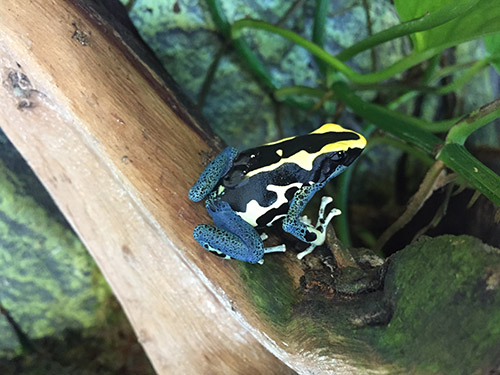
Above and below: Charismatic Neotropical Poison Frogs transporting their tadpoles (i.e., exhibiting their parenting skills). (Images courtesy of Eva Fischer.)
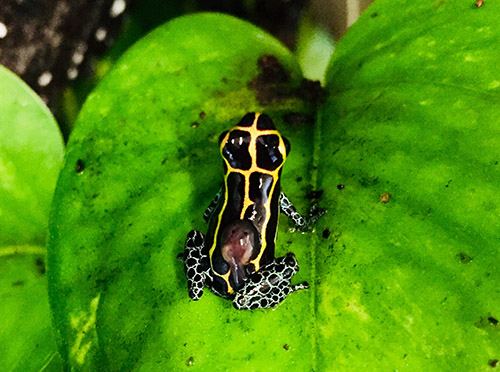
In further defense of her “pets,” she claims that they’re only poisonous in their natural habitat. In fact, she reports that they're not at all dangerous in the lab or in a classroom setting because they don't make their own toxins, but get them from their diet. “In a lab,” she declares, “we're not feeding them the right kinds of things, and so they're totally toxin free and safe.”
She shares additional qualities that make them excellent for the lab or classroom—their colors are not genetically related to whether or not they’re poisonous. “So they're really beautiful and brightly colored, even when they're not toxic.”
Probably the most intriguing characteristic of these frogs is this: the fact that they’re poisonous in their natural habitat impacts their “personality,” making them more outgoing. “They don't ‘know’ that they're not toxic,” she explains of their behavior even when not toxic. “So because they're typically toxic in the wild, they're more bold and ‘out and about’—easier to observe than other types of frogs that would hide from you. And so they keep doing that even when they're not toxic, which is one of the reasons that they're pretty cool for a classroom type setting—they're just out and about more.” Another characteristic that makes them perfect for the classroom? They're also diurnal; they're awake during the day, while most other frogs are sleeping.
The frogs’ native habitat is the tropical rain forests in Central America and the northern part of South America. Plus, there’s one species of poison frogs that lives in Hawaii—an invasive population of frogs that was introduced to Hawaii by mistake. (Oops!) “It should not be there,” Fischer asserts. “That's not where it's from, but that's the right kind of climate, I guess, for them.”
So, how did Fischer end up researching frogs? Did she love frogs as a kid and, thus, was always bringing them into the house (to her mother’s chagrin)?
“I love the frogs,” she acknowledges, “but I'm not really a frog biologist per se. What I have always been interested in is that, if we look at animals, including ourselves, we see that really different kinds of animals do similar kinds of behaviors.” Some behaviors to which she’s referring include aggressive behaviors, mating and courtship, and parental behaviors. “So what really fundamentally interests me,” she continues, “is, when we see these same kinds of behaviors evolve, does evolution use the same building blocks to build them?”
In other words, does evolution keep using the same parts of the brain and the same molecules to make a good parent, or are there lots of ways to build these behaviors? She employs a metaphor about a house to explain:
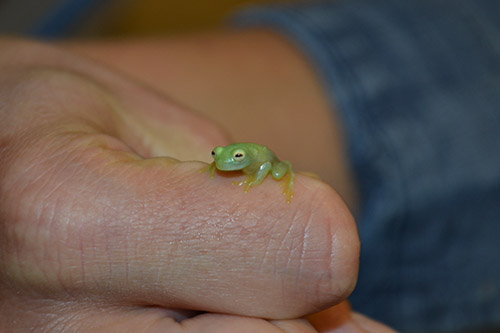
Fischer exhibits one of her tiny nonpoisonous, nocturnal frogs.
“It's sort of the equivalent of a house is a house, but do you always build a brick house, or do you sometimes build a wood house, or a straw house, or whatever?”
So how did Fischer end up researching frogs? “What most people don't know is that they're really good parents—this specific family,” she explains, then goes on to share something else that’s cool about them—they share the parenting load, meaning sometimes Dad gets stuck “changing the diapers.”
For example, most research on parental care using mammals looks at one area: maternal care. “Because, of course, with lactation, which is a hallmark of mammals, you can't get rid of mom, basically. Whereas with the frog,” she explains, “we actually have some species where it's only dad, some species where it's only mom, and some species where it's both of them. It's always parental care, but it's kind of different forums, different flavors. And so we can ask that question really nicely about, ‘Do we use the same molecules and brain regions and so on?’”
She shares something else intriguing about frogs: while with mammals, maternal care is the baseline state, “in frogs and fish, actually, paternal care—male care—is ancestral and is more common.”
Regarding how what she discovers about frog behavior might translate to human beings, Fischer says, “I think it is applicable in so far as this question of, ‘Does evolution reuse the same building blocks?’…That's another reason I really like comparative research, where you're looking at lots of different species, I think it lets us tease apart what are the shared core fundamental principles versus what's species specific.”
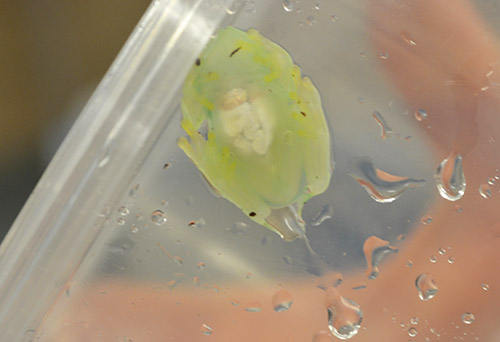
One of Fischer's glass frogs, so named because they're practically transparent. For instance, the white mass in the center is its digestive system; the smaller beige mass just above that is its heart, which could actually be seen beating.
While Fischer touts the use of frogs in her labs, she also advocates using them in the classroom. In fact, she’s hoping to implement locally the Frogger School Program she helped her postdoc advisor design and which they were implementing in California schools. “One of the goals,” she says of the program, “is to build something that's also longer lasting, so that it'll have a bigger impact.” Iin the past, they’d partnered with classrooms to get frogs into classrooms so teachers and students could “interact with them and kind of get to know them.” They also had a high school class that actually did projects on the frogs, doing science experiments with samples from their lab.
Coming at K–12 partnerships from a different direction, she recalls that teachers used to spend time in their lab as research interns, as well as some students. However, while Fischer calls this research aspect, “super fun and really rewarding to have students and teachers,” she adds, “but on that level, we're sort of limited, because there's only so many humans that I can mentor in my lab.”
So one direction she hopes to go in the future to expand the Frogger program is to create online content that teachers can use. The idea is that teachers would each get a frog in their classrooms, which would be sort of a class mascot or pet they and their students would get to know. Then, when the teacher is addressing a certain area such as metabolism, for example, there would be a module they could use with the frog. “So the frogs are sort of this anchor or theme that you can keep coming back to,” she suggests. “So for whatever you're teaching, we provide you with a little frog example.”
Knowing that teachers are busy and have a great deal going on, Fischer hopes to develop a tool they could tap into with relatively low investment. She also wants to ensure that what they’re designing is in line with the teachers’ curriculum and meets core curricular standards. “I don't want to create more work for you,” she explains. “I want you to have something that's a useful resource.”
The last piece of Frogger she’d like to introduce is to create an online resource that would allow classrooms to interact with each other. For instance, different classrooms would observe their frogs then post some observations or pictures or whatever, allowing classrooms to compare and contrast.
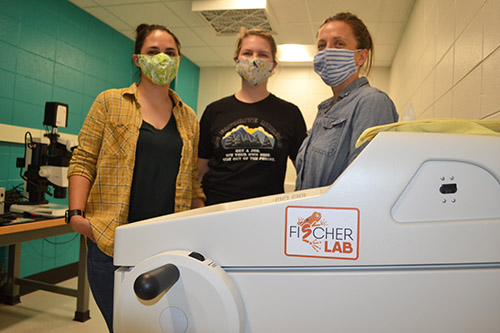
Fischer (right) and her researchers by a large piece of equipment in her lab.
Also, for schools not in close proximity, the program would try to connect them with a local person who could come to visit their classroom and talk about frogs. The Frogger program would also solicit grant funds help to defray some of the costs. She explains that in the past, because of university regulations, frogs used for research had to stay in the lab and couldn’t be given away. However, she and her mentor applied for a grant, then used those funds to buy Terraria, which can be pretty expensive, for classrooms because that's actually the most expensive part. Then the classrooms could just buy a frog, which worked pretty well because then they got to choose their own frog. The Frogger team would also be there to act as support staff.
Fischer’s plan for the immediate future is to get some of these programs in place, then, in a few years, apply for an NSF (National Science Foundation) Career grant, which helps supply funding for research for young faculty, plus outreach, a required component in a Career grant. “So this is one of the reasons I would like to start these things early, so that by the time I'm applying for a Career grant, I can say, ‘Okay, I've put these pieces in place. And this is part of what I want to do for my Career grant is to work with these schools and expand on this thing.’”
So what’s the benefit of doing a program about frogs in schools? According to Fischer, “We talk a lot about what we can do at the university level to increase diversity in STEM to reach other populations, etc. But I think if we don't worry about that until kids are 18 and we're at the university level, we've missed the boat. So I just think that we've got to start earlier.”
She also says she finds outreach rewarding personally. “And I really enjoy it, frankly. So on that level, I guess, it’s somewhat selfish, but I also think I've found it rewarding also, especially working with teachers.”
She particularly enjoys sharing the connection between what's actually happening with research and education. Plus, she feels having real-life examples can be good. For example, her understanding from talking with people in education is having some phenomenon that serves as an anchor throughout the semester.
“So you have all these different topics, but then you keep pulling examples from the same system. And one of the reasons I think that's particularly cool—something that I love about biology or science in general—is everything's kind of connected. And so I think it's neat to be able to use an example that then highlights the idea, ‘Okay, we learned about metabolism, and now we're learning about climate, but these things are really related actually.’” So Fischer’s goal is to “help show kids or show people in general how all these pieces are not really as separate as they seem.”
She also hopes to show students that scientists are diverse. “I think that this is changing, but people, when they think of scientists, tend to think of someone who looks somewhat like Einstein—older, a white man, and crazy. And so to me, it's also, ‘I'm a scientist, and this is what I look like!’ So I think maybe it's good to go into classrooms and have them see that or to try to also connect people with a local scientist to give them the idea that scientists are also perhaps more diverse than it appears to a girl, an average five-year-old.”
Author: Elizabeth Innes, Communications Specialist, I-STEM Education Initiative; photographs: Elizabeth Innes, unless noted otherwise.
More: Biology, Faculty Feature, 2020

IB Professor Eva Fischer (left) and two of the grad students in her lab.













.jpg)
















